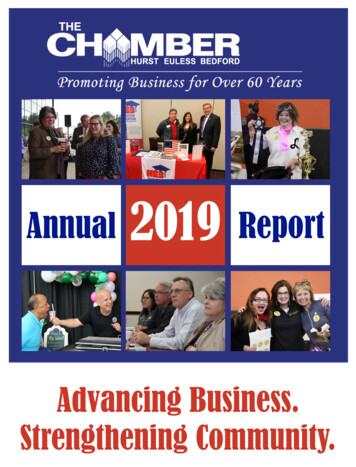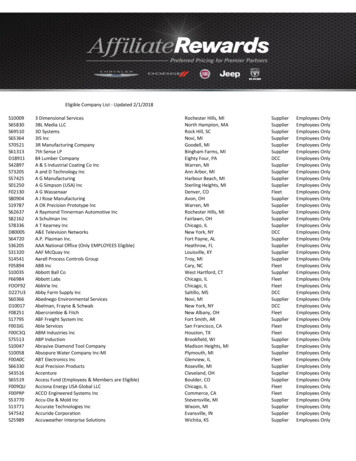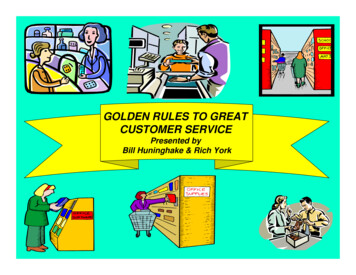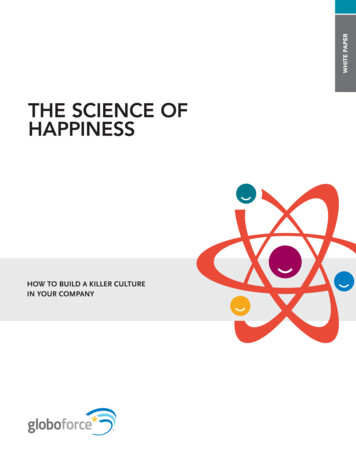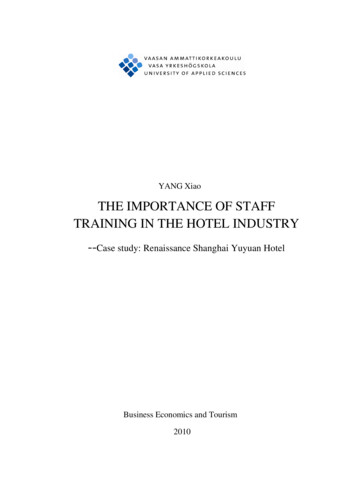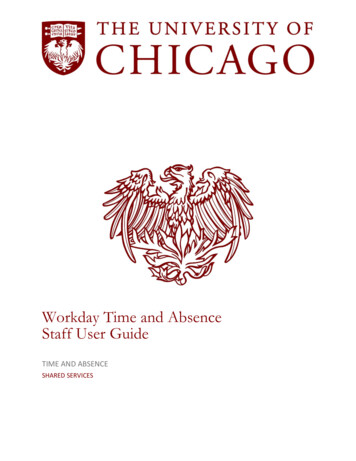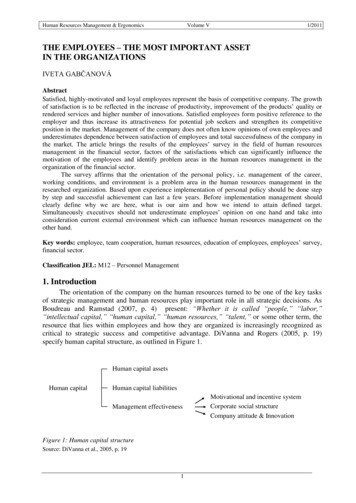
Transcription
Human Resources Management & ErgonomicsVolume V1/2011THE EMPLOYEES – THE MOST IMPORTANT ASSETIN THE ORGANIZATIONSIVETA GABČANOVÁAbstractSatisfied, highly-motivated and loyal employees represent the basis of competitive company. The growthof satisfaction is to be reflected in the increase of productivity, improvement of the products’ quality orrendered services and higher number of innovations. Satisfied employees form positive reference to theemployer and thus increase its attractiveness for potential job seekers and strengthen its competitiveposition in the market. Management of the company does not often know opinions of own employees andunderestimates dependence between satisfaction of employees and total successfulness of the company inthe market. The article brings the results of the employees’ survey in the field of human resourcesmanagement in the financial sector, factors of the satisfactions which can significantly influence themotivation of the employees and identify problem areas in the human resources management in theorganization of the financial sector.The survey affirms that the orientation of the personal policy, i.e. management of the career,working conditions, and environment is a problem area in the human resources management in theresearched organization. Based upon experience implementation of personal policy should be done stepby step and successful achievement can last a few years. Before implementation management shouldclearly define why we are here, what is our aim and how we intend to attain defined target.Simultaneously executives should not underestimate employees’ opinion on one hand and take intoconsideration current external environment which can influence human resources management on theother hand.Key words: employee, team cooperation, human resources, education of employees, employees’ survey,financial sector.Classification JEL: M12 – Personnel Management1. IntroductionThe orientation of the company on the human resources turned to be one of the key tasksof strategic management and human resources play important role in all strategic decisions. AsBoudreau and Ramstad (2007, p. 4) present: “Whether it is called “people,” “labor,”“intellectual capital,” “human capital,” “human resources,” “talent,” or some other term, theresource that lies within employees and how they are organized is increasingly recognized ascritical to strategic success and competitive advantage. DiVanna and Rogers (2005, p. 19)specify human capital structure, as outlined in Figure 1.Human capital assetsHuman capitalHuman capital liabilitiesManagement effectivenessFigure 1: Human capital structureSource: DiVanna et al., 2005, p. 191Motivational and incentive systemCorporate social structureCompany attitude & Innovation
Human Resources Management & ErgonomicsVolume V1/2011Motivation, delegation of powers gets its importance at the present time as well. AuthorsFoot and Hook (2005), Armstrong (2002), Wagnerová (2008) and Koubek (2004) unanimouslyagree upon the fact that the management of the performance is the process by which theperformance of the organization, team and individual improve and is used by the leaders formanaging. Hall (2008, p. 194) clearly declares, that the very best way for managers to improveemployee performance is to set clear expectations and hold regular business reviews to thoseexpectations. The scientists try to discover the dependence between working performance andmotivation. However, the answer is not unequivocal in all cases. Porvazník (2007, p. 125)underlines that motivation profile of each employee differs. Regardless this, where the motifscome from; a man is the most motivated one providing that external and internal motifs are in thebalance. The level of the application of the skill to motivate or encourage employees is inpractice judged according to the number of the satisfied employees in the organization, by thefluctuation rate and not by its results.On the other hand Khan et al. (2010, p. 49) researched that a motivation strategy maypossibly have the power of enhancing motivation in one way and diminishing it in others. Tomake sure the success of motivational tools, it is important to consider the uniqueness of thesituation and the diversity of the concerned group .It is the job of management to considerdifferent alternatives according to situation. Wagnerová (2008, p. 18) in her publication statesthat the research of motivation in its beginning leads to the founding that employees withapproximately same working skills can have similar incomes but still quite different motivationand performance. The task of the working performance has been gradually recognized as a toolof the motivation and development in the USA, in the 50-ties. Based upon the research,Armstrong (2002, p. 433) publishes interesting opinion that there is not significantly positiverelation between satisfaction and performance. The assumption that rather a good performancebrings satisfaction than a satisfaction brings a good performance is not confirmed.Wagnerová (2008, p. 29) introduces that certain optimum is applied for performance ofwork. In accordance to Yerkes – Dodson’s law, it can be said that the relation of motivation andperformance is not linear but it has the shape of the reversed “U“. Higher motivation does notautomatically mean better performance. The optimum level of motivation depends on thecomplexity of task. Lower level of motivation is optimal at the difficult tasks. While higherlevel of motivation for better performance is required for easier tasks. Optimal motivation leadsto the maximum performance. The management of working performance is closely related to theremuneration of the employees. As it is given by the Koubek (2004, p. 57) remunerationrepresents a certain background of working performance management and thus serves and helpsthe action on the scene to go successfully.According to Emansa and Kerstena (2001, p. 45), it is unreal to assume that introduction of“pay for performance“, pay according to the performance shall change each employee duringone night into a high-performance and motivated individual. Furthermore, some studies, on thecontrary prove that motivation effects of that system can be negative providing the justice in theremuneration system is not guaranteed. Herzberg et al (1957, p. 15) also mentions doubtregarding the efficiency of money, as its lack does not lead to the satisfaction, its sufficiencydoes not lead to the long-term satisfaction.Pursuant to Borsíková (2008, p. 2), the situation is similar in our conditions because thisissue is being complicated by the unfavorable economic situation with high rate ofunemployment and low level of salaries. It seems that these conditions narrowed the whole areaof motivation into the only one “motivator“– money. The author of the abstract partially acceptsthe opinion of Borsíková (2008), although it is always possible to find way and solution tomotivate employees so that the financial remuneration is not the only one incentive for higherworking performance. According to research on topic “Ideal employer 2009” Švecová (2009, p.2
Human Resources Management & ErgonomicsVolume V1/20114) presents, that main factor of satisfaction (but not motivator) is salary, direct financial appraisal(84%). Surprisingly on second place is job description (74%) then personal development ofemployees (63%). On fourth place is direct supervisor and work environment and fifth are fringebenefits.Management of working performance represents the combination of working performance,education and remuneration of employees. Management of working performance in theorganization, its content and processes are influenced by many other factors and determinantsincluding culture of the organization, management’s style and structure of the organization.Interesting opinion is introduced by Porvazník (2007, p. 125), who mentions that performancequalities of the subjects of management are influenced by the relation to the work to a greatextent. The sense of work is not only to earn money for living but even to create values. Theauthor supports Porvazník’s idea (2007), who summarizes further that the company should eventry to identify the reasons of the employees’ stress and consequently eliminate them.When company wants to increase the employees’ performance managers need to answeron question: “What kind of motivator would increase the performance of their employees?” Hall(2008, p. 215) explains that when managers talk about performance improvements, they focus ontraining and appraisals, but training and appraisals are parts of en engine – not the engine itself.Furthermore Fitz-Enz (2009, p. 16) highlights that data and people are inexorably linked as neverbefore. Either one without the other is suboptimal. Rather than bigger buildings or moreequipment, employees need timely, relevant, and, most important organized data. Management’sresponsibility today is to combine people with information on a timely basis for severalpurposes. Information is one key to performance management and improvement. At the sametime Bojnec and Gašparič (2010, p. 22) present that the value-added per employee is positivelyand statistically significantly associated with the ways of providing incentive in the decisionmaking process in the company with participation and responsibility in the decision-making ofthe lower level management.Ulrich (2005, p. 207) expresses distinctly how human capital important is: ”Human capitalis intangibles, which represent value derived from choices about what happens inside the firmand from how investors value those decisions, rather than from its physical assets.”2. Course of ResearchThe research defines following hypotheses:H1: Company’s culture of the organization form the basis for increasing employees’performance.H2: Motivation and support of employees’ personal development are closely connected.H3: Non-monetary motivation of employees plays a very important role to manage theperformance of employees.One of the tools to verify defined scientific hypotheses is the collection of primary data bymeans of own empiric research carried out by questionnaire for the employees of theorganization in the financial sector. The start-up of online questionnaire research requiresmeeting with the employees of a personal department. The goal of the meeting is to rearrange aquestionnaire into the required form so it corresponds to the requirements of scientific researchon one hand and to reach a defined goal on the other hand. The consultation with personalmanagers brings many benefits as it leads to the elimination or more precisely to the addition ofsome questions which are relevant from the point of defined goal.The analysis of the surveys’ results requires the application of a quantitative approach dueto the analysis of causal relations among individual variables. The qualitative research is alsoapplied in order to comprehend the results. The scientific research requires the application of3
Human Resources Management & ErgonomicsVolume V1/2011causal analysis which is focused on the casual connections between two phenomena. Theapplication of causal analysis has its reasoning because by this method causal connections withinthe frame of human resources are researched. At the same time, induction and deduction areapplied to analyze results. These methods are mainly applied for formation and processing ofphenomena and generalization of gained knowledge based upon which the synthesis andconclusions are performed.The employees’ survey was performed in period starting June 14th, 2010 and ending Juneth28 , 2010 in the organization of the financial sector in Czech Republic and the goal of theemployees’ survey is the analysis of a contemporary status of perception of human resourcesmanagement by the employees in the organization of the financial sector. At the same time, theresearch is intended to find out problem areas of human resources management in the financialsector. In order to reach a defined goal, the processing of questionnaire research requires theapplication of several methods of scientific research. The return of the questionnaire was 88.35%and the questionnaires are delivered to all employees (130) of the organization in the financialsector. The research also includes managers of the organization on all levels.Questionnaire is divided in to the areas as follows:1. Cooperation with my direct superior – questions from this area refer to the direct supervisorand mutual collaboration between superior and employees (Figure 2, 3, 4).2. Employee’s growth – questions from this area relates to possibilities of career growth,trainings, improving the qualification (Figure 5, 6, 7).3. Strategy of our department – questions that relates to the long-term goals and orientation ofemployee’s department.4. Cooperation and working performance of the department – questions relate to departmentwhere employees work, working environment, handling with the problems, teamwork(Figure 9).5. Cooperation with other department – questions refer to all departments the employeescooperate with on a regular basis in the course of your daily tasks (Figure 8, 10).6. Human resources management – questions relate to level of personal policy of organization,corporate culture (Figure 14).7. Wages – questions refer to salary policy, performance rewarding, bonuses (Figure 15).8. Commitment to the company – questions refer to employee’s commitment to organization.9. Company’s management – questions relate to level of managing of the organization,corporate social responsibility, outspokenness (Figure 11, 12, 13).The questions in questionnaire are formulated in order to fulfill validity, have informationvalue and thus contribute to the accomplishment of the defined goal. The article contains 14graphs where are depicted results from individual questions from the questionnaire. The graphswere chosen in order to demonstrate defined hypothesis and goals of the research.3. The analysis of the resultsProcessing and evaluation of the results based upon the on-line survey research is carriedout by means of spreadsheet. Graphs which present core and the most important results of theindividual areas are selected based upon the experience in the human resources and proving ofhypothesis or more precisely fulfillment of defined goals in the research.The employees stated that it is very important if superior renders all information, meansand support for reaching agreed goals in the area of cooperation with direct superior (Figure 2).The importance of being informed is also presented in Figure 3 which confirms that it is of greatimportance to organize regular meetings. Almost 63% of the employees approve that bothdirections communication flow between superior and subordinate has its good reasons andshould be a part of each company’s culture.4
Human Resources Management & ErgonomicsVolume ,00,00,0not at allslightlymoderatelyalmost totallyvery muchFigure 2: Rendering of required information by direct superior in %Source: own not a t a llslightlymodera telya lmost tota llyvery muchFigure 3: The importance of regular meetings in %Source: own studyAt the same time, it is confirmed by the employees that successful reaching agreed goals isinfluenced not only by the information level but the importance lies also in the engagement ofthe employees in the decision-making process which influences their work, what is confirmed bythe result of 54.1% shown in Figure 0not at allslightlymoderatelyalmost totallyvery muchFigure 4: Engagement of the employees in the decision-making process in %Source: own study5
Human Resources Management & ErgonomicsVolume V1/2011The importance of the cooperation between superior and employee to fulfill tasks isconfirmed by the answers on the question: “Does your superior devote enough time to discusswith you your working tasks and goals?”, (Figure ,0not at allslightlymoderatelyalmost totallyvery muchFigure 5: Discussion on working tasks and individual goals in %Source: own studyIt follows from the research that one of the important factors which directly influencesreaching strategic goals is the cooperation with direct superior and support of employees tofulfill tasks. It can be stated that employees appreciate mainly open communication, cleardefinition of goals and delegation of powers.Further, it is researched that growth and professional development of the employee as oneof the possible problem areas of human resources management. Figure 6 shows illustrativelythat annual employee dialogues are not performed what as a final result can influence not onlyemployee’s performance and his/her motivation but event the motivation to reach strategic 0,05,00,0not at allslightlymoderatelyalmosttotallyvery muchFigure 6: Discussion on the working performance and professional growth in %Source: own studyIt can be stated that the importance of annual employees’ dialogues is underestimated bythe employer. However, it must be noted that the evaluation of employee’s performance,evaluation of individual tasks and identification of personal development are key factors tomotivate employee. The important fact regarding annual dialogues is also the form and style ofits performance. Otherwise, the dialogue can have the opposite effect for the employee’sperformance.6
Human Resources Management & ErgonomicsVolume V1/2011The question which is focused on the significance of the qualification, capabilities andknowledge application – the employees (70.8%) confirm that (Figure 7), that it is vital not onlyto pass trainings focused on the support of the personal growth but decisive factor is also theapplication of the qualification, capabilities and knowledge in order to reach goals. In that casethe most frequent answers are: application of expert knowledge and soft skills for their 14,20,0not at allslightlymoderatelyalmost totallyvery muchFigure 7: The application of gained qualification, capabilities and knowledge in %Source: own studyOne area of questions includes questions orientated on the team cooperation in the departmentand among departments. The aim of the questions is to confirm or not if team work, trust in teamare key factors of the employees’ satisfaction. Figure 8 presents that the cooperation in thedepartment or more precisely among departments plays very significant role in the job 10,05,00,02,30,0not at allslightlymoderatelyalmost totallyvery muchFigure 8: Cooperation within the company in %Source: own studyThe employees confirm that team cooperation is important not only among individualdepartments but of the same importance is the support of team work by superior (Figure 9).7
Human Resources Management & ErgonomicsVolume 010,05,02,32,30,0not at allslightlymoderatelyalmost totallyvery muchFigure 9: The importance of team work in %Source: own studyFrom the research follows that the support of team works is to be a part of each company’sstrategy or more precisely culture as a tool for reaching goals. At the same time, the employeeswould appreciate yearly teambuilding and outdoor activities to support networking amongindividual departments within the company. However, most of the employees confirm that theydo not receive all needed information from other departments to reach defined working goals(Figure 10).Figure 10: Communication among departments in %Source: own studyThe employees state that successful fulfillment of defined goals requires the knowledge ofcompany’s results for previous period Figure 11 and goals of the organization for future periodFigure 12.8
Human Resources Management & ErgonomicsVolume V1/2011Figure 11: The importance of being informed about previous results in %Source: own studyFigure 12: The importance of being informed about future plans/intentions in %Source: own studyHowever, the results show that long-term goals and strategic orientation of the departmentor more precisely of the company are not discussed sufficiently Figure 4,45,000,0not at allslightlymoderatelyalmost totallyvery muchFigure 13: Management’s knowledge on strategic goals in %Source: own studyThe subject of the research is also to find out the level of human resources management inthe company. 36.4% of the employees evaluate personal policy in the organization only on theaverage and almost 30% does not consider human resources management to be sufficient. Fromthe above mentioned follows that career management, working conditions and environment or9
Human Resources Management & ErgonomicsVolume V1/2011more precisely salary do not contribute to the increase of the working performance in theresearched organization.Figure 14: Level of human resources management in %Source: own studyOne of the researched areas is the remuneration, too. The employees affirm thatremuneration is not the most important motivator for them to reach defined tasks Figure 15.25,022,725,022,720,015,015,913,610,05,00,0not at allslightlymoderatelyalmosttotallyvery muchFigure 15: Remuneration as a motivator in %Source: own studyThe employees confirm that non-monetary forms of motivations are of greater importanceto them in comparison to monetary forms of the evaluation.4. ConclusionBased upon the results, it can be stated that defined goal is reached because the resultsshow a complex view on the management of human resources. At the same time, the researchpresents a detailed answer which factors influence the performance of employees.Simultaneously, it is found out which areas require increased attention by managers of humanresources in order to increase the performance of employees and thus the overall performance ofthe organization.Employees’ survey is one of the important tools of the communication means in eachcompany. Opinions of employees regarding the company can support the company for the right10
Human Resources Management & ErgonomicsVolume V1/2011development and direction. At the same time, survey can help to set personal policy correctlyand to motivate employees. Following the above mentioned there are factors which influenceworking performance of employees and that is:1. Both direction communication between superior and subordinate. More than 50% of theemployees consider the fact to be informed to be a very important part of their workingperformance. The result more than 50% confirms the hypothesis No 1, i.e. that two-way flowof information between management and employees should be a component part of eachcompany’s culture especially in case that company intends to increase its performance.2. Co-decision and engagement into the decision-making process. 33.3% of the employeesconsider that factor to be very important one and 20.8% of the employees consider it to beimportant.3. Cooperation with direct superior and support of the employees to fulfill tasks.4. Knowledge of the company’s strategy or more precisely vision of the company, where thecompany is heading in short-term or more precisely long-term and at the same time theknowledge of past periods results (72.7%).5. Support of career growth and education of employees. Employees (70.8%) state that supportof individual development or more precisely personal growth significantly influence workingperformance. This result shows and confirms the hypothesis No 2 that if the personal policyis set correctly, i.e. personal policy even includes the support of own employees personaldevelopment, the motivation of employees can be increased.6. Cooperation in the department or more precisely among departments is considered to be adecisive factor which helps to guarantee efficient working performance of the employee.Contrary to Borsíková (2008, p. 2), the wage has not been the incentive to reach betterworking results for a long time based upon the research. Non-monetary forms of motivation aregetting their first place. According the research internal communication, personal developmentand employees’ education are the elements of non-monetary motivation. Above-mentionedresults confirm the hypothesis No 3 that monetary motivation is only a short-term factor whichinfluences the performance of employees. The satisfaction of employees is influenced by humanresources management itself to a great extent as well as set personal policy in the company. It isessential to realize at the same time that human resources management and its requirements isbecoming the center of the attention of each employer lately. The results confirm a narrowconnection between working performance of the employee and reaching defined results of theorganization in the financial sector.The research affirms that the orientation of the personal policy, i.e. management of thecareer, working conditions, and environment is a problem area in the human resourcesmanagement in the researched organization. Based upon experience implementation of personalpolicy should be done step by step and successful achievement can last a few years. Beforeimplementation management should clearly define why we are here, what is our aim and how weintend to attain defined target. Simultaneously executives should not underestimate employees’opinion on one hand and take into consideration current external environment which caninfluence human resources management on the other hand. Furthermore employer should notover motivate own employees because it can lead to decreasing the performance. Top leaders canuse modern method such as Balanced Scorecard to increase employees’ performance. At thesame time support tools such as employees’ survey, being informed by regular meetings, andvisualization in the company or more precisely management’s meetings with employeesmotivate employees to a higher working performance significantly and at the same time it helpsto improve performance of the company and to fulfill defined human resources strategy.11
Human Resources Management & ErgonomicsVolume V1/2011References:[1] ARMSTRONG, M.: Řízení lidských zdrojů. Praha. Grada Publishing. 2002. ISBN 80-2470469-2[2] BOJNEC, Š. – GAŠPARIČ, K.: Factors of efficiency of multinational companies inSlovenia. [online] Journal of US-China Public Administration, July 2010, p. 22, Vol. 7,No 7. ISSN 1548-6591[3] BORSÍKOVÁ, B.: Ako prijať a uvoľniť zamestnanca. Bratislava. Dr. Josef RaabeSlovensko. December 2008[4] BOUDREAU, J. W. – RAMSTAD, P. M.: Beyond HR. Boston. Harvard Business SchoolPress, 2007. ISBN 978-1-4221-0415-6[5] DiVANNA, J. A. – ROGERS, J.: People – the New Asset on the Balance Sheet. New York.Palgrave Macmillan. 2005. ISBN 978-1-3039-3689-9[6] EMANS, B. J. M. – KERSTEN, W.: Motivational Consequences of Procedural (In)justiceIndividual Ppay-for-perfomance Systems. Praha. Tenth European Congress on Work andOrganizational Psychology, 2001[7] FITZ-ENZ, J.: The ROI of human capital. New York. Amacon. 2009. ISBN 978-0-81441332-6[8] FOOT, M. – HOOK, C.: Personalistika. Brno. CP Books. 2005, 462 p. ISBN 80-7226-5156[9] HALL, B. W.: The New Human Capital Strategy. New York. Amacon. 2008. ISBN 978-08144-0927-5[10] HERZBERG, F. W. – MAUSNER, B. – SNYDERMAN, B.: The Motivation Work. NewYork. Wiley, Library of Congress, 92-16067. 1957. ISBN 1-56000-634-X[11] KHAN, K. U. – FAROOQ, S. U. – ULLAH, M. I.: The Relationship between Rewards andEmployee Motivation in Commercial Banks of Pakistan. [online] Research Journal ofInternational Studies. 2010. Issue 14[12] KOUBEK, J.: Řízení pracovního výkonu. Praha. Management Press. 2004, 210 p. ISBN 807261-116-X[13] PORVAZNÍK, J.: Celostný manažment. Poradca podnikateľa. 2007. ISBN 978-80-8893173-7[14] ŠVECOVÁ, S.: Personálny manažment. Bratislava. Dr. Josef Raabe Slovensko. Október2009[15] ULRICH, D. – BROCKBANK, W.: The HR Value Proposition. Boston. Harvard BusinessSchool Press. 2005. ISBN 1-59139-707-3[16] WAGNEROVÁ, I.: Hodnocení a řízení výkonnosti. Praha. Grada Publishing. 2008. ISBN978-80-247-2361-7.Address of author:Ing. Iveta GABČANOVÁFaculty of Management and EconomicsTomas Bata University in ZlínMostní 513976001 ZlínCzech Republice-mail: ivetagabcanova@gmail.com12
of strategic management and human resources play important role in all strategic decisions. As Boudreau and Ramstad (2007, p. 4) present: “Whether it is called “people,” “labor,” “intellectual capital,” “human capital,” “hum
